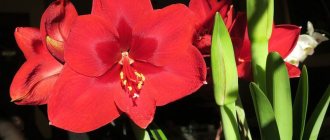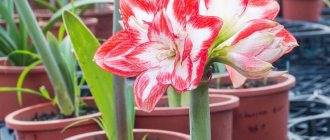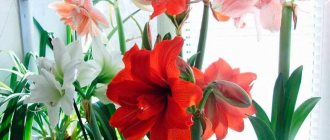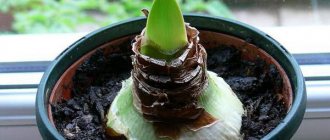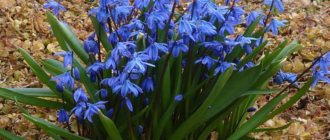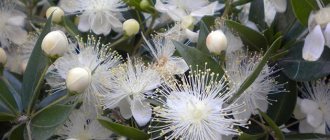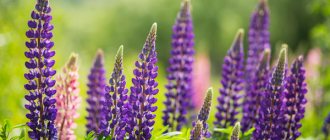Amaryllis is a bulbous flowering plant of the same family. Perennial. Homeland - Olifants River Valley in southern Africa. The distribution area is quite wide. The plant is found in South Africa, Australia, and Japan.
The name of the flower is associated with the famous ancient Roman poet Virgil. Amaryllis, a beautiful shepherdess, appears in his works. From ancient Greek the name is translated as sparkling.
Description of amaryllis
Dark green smooth long leaves are arranged in two rows. The shape is similar to a narrow belt. Inflorescence of an umbrella type.
The root system is a large round bulb, slightly flattened on the sides. Diameter - 5 cm. It is covered with grayish scales, and a dull white rhizome grows from the bottom. The bulb retains its viability for 10–15 years.
The flowering period begins in mid-spring. Duration – 1.5 months. Initially, a fleshy peduncle 0.6 m tall is formed. An inflorescence resembling an umbrella is formed at the top. The shape of the 6-petal flowers resembles a bell. Color: white, cream, pink, yellow, purple-red. In the center there are long stamens and the ovary.
After flowering, fruit boxes are formed, containing more than 6 seeds. They ripen in 30 days.
FAQ
Why doesn't amaryllis bloom?
As a rule, the absence of inflorescences on amaryllis is associated with improper maintenance conditions:
- Lack of light;
- Not enough nutrients;
- No rest period;
- A sign that the plant is old and needs to be replanted and the resulting bulbs removed;
- The bulb is deeply planted;
- Diseases of the root system.
It is important to consider that a baby bulb can bloom only in the third year after planting, and a plant grown from seeds blooms only after seven years.
Why do amaryllis leaves turn yellow?
There may be several reasons for yellowing and deformation of leaves:
- Damage by aphids or thrips;
- Excess moisture.
If the leaves begin to dry out, it is likely that the plant is preparing for a period of dormancy. In this case, the process is natural and does not require the intervention of a grower. It is necessary to reduce watering and cut them off as the leaves dry completely.
Distinctive features of amaryllis
Amaryllis and hippeastrum are often confused. Both plants belong to the same biological group. The genus Hippeastrum is more numerous. It has approximately 90 species found naturally.
The differences between them are presented in the table:
| Comparison sign | Amaryllis | Hippeastrum |
| Bloom | Aug. Sept. | February March. |
| Aroma | It shows up clearly. | Absent. |
| Flower size (diameter in cm) | 10-12 | 6-8 |
| Number of flowers | 4-6. Occurs 12. | 2-4. Maximum – 6. |
| Color | From white to burgundy, there are shades of pink. | Snow-white, lilac, yellow, purple, light green. Variable combination of colors. |
| Presence of leaves in the flowering phase | None. Resume growth after fertilization. | Present. |
| Peduncle | Dense, without voids. Length 0.4-0.6 m. Has a purple tint. | Green hollow tube 70 cm long. Makes a slight cracking noise when pressed. It has a grey-brown color. |
| Bulb shape | Pear-shaped. Covered with gray scales. | Round, elongated at the bottom, slightly compressed on the sides. |
| Motherland | Africa. | South America. |
Soil selection
The plant is replanted once every 3-4 years. Amaryllis does not particularly like frequent transplants.
To bloom profusely, it must completely fill the entire space of the flowerpot, so for replanting take a small new pot, which differs from the old one in a slightly larger volume (by 2-3 cm).
With the right choice of soil you can achieve this result.
This volume is necessary to restrain the formation of daughter bulbs and provoke abundant flowering.
To eliminate old depleted soil, you can remove the top layer of soil. The operation is carried out carefully so as not to damage the top layer of the bulb and minor root branches.
If the time has come to replant the shrub, the procedure should be carried out only after the buds have faded. The soil is prepared with the optimal composition:
- Sod land - 2 parts;
- Sand – 1 part;
- Humus – 1 part;
- Peat – 1 part;
- Ash is a small amount.
All components are combined into one batch. Then you should check the acidity of the prepared soil substrate. The optimal value should be at the level of 6-6.5.
At the bottom of the flowerpot, drainage must be laid out - expanded clay, pebbles or broken bricks. It is necessary so that the water does not stagnate in the pot, thereby not provoking the appearance of various diseases or the infestation of harmful insects. A layer of earth is poured on top and a bulb is installed, pressed on all sides by soil.
Thus, a correctly selected substrate allows red amaryllis to bloom profusely and brightly, saturating the surrounding interior with bright colors.
Types and varieties of amaryllis
For a long time, amaryllis was considered a plant of the same type. Now there are two main types of decorative flowers:
| View | Description |
| Amaryllis belladonna | Develops from elongated, round, pear-shaped large bulbs. Green stem 0.5 m high. Has a pleasant, delicate aroma. Belladonna blooms in winter and goes dormant in summer. |
| Amaryllis Paradisicola | It differs in the number of inflorescences: there are 21 of them. It has a pungent odor. Pink flowers. The saturation of the shade increases as the buds open. It has not become widespread in indoor floriculture. |
Based on these species, breeders have developed new varieties. They are distinguished by color, shape, size of flowers:
| Variety | Flower |
| Durban | It is shaped like a bell. Red with a light spot at the base. |
| Parker | Pink with a yellow center. |
| The Snow Queen | Snow-white glossy flowers with a beige edge. |
| Faith | Light pink with a pearly finish. |
| La Paz | Green with red border. |
| Macarena | Terry purple with white stripe. |
| Minerva | Variegated striped petals. |
| Grandior | Gradient transition from soft pink to a more saturated shade. |
You can get an unusual hybrid yourself. During flowering, pollen is collected from the stamens of one variety and transferred to another species. From the obtained seeds, a new variety is grown that combines the parental color.
Bloom
Photo: blooming amaryllis
Amaryllis usually blooms in late summer. If you want to speed up the flowering process, you can transplant the bulb 2 months before the desired flowers are received into a new container.
Photo: blooming amaryllis
Caring for amaryllis at home
Amaryllis is more capricious in its contents than hippeastrum. Breeding depends on the period in which the plant arrives.
| Conditions | Vegetation phase | State of rest |
| Flower location | South side. Shading from direct sunlight. | Dark, cool place. |
| Lighting | Bright diffused light 16 hours a day. | Not required. |
| Watering | Use settled water. Water twice a week. Before flowering, slightly moisten the buds. Optimal humidity is 80%. | Watering is stopped. The soil is sprayed. Humidity in the place of detention is 60%. Watering is resumed when the peduncle reaches a height of 12 cm. |
| Ventilation | Keep in a well-ventilated area without drafts. | |
| Temperature | During the day +22…+24 °C, at night +18 °C. Sudden temperature changes are not allowed. | +10…+12 °C constantly. |
| Feeding | Once a decade. Fertilizers – Emerald, Agricola, Kemira. In the flowering phase, apply once every 5 days. Preference is given to fertilizers with a high content of potassium and phosphorus. | Not used. |
Features of planting amaryllis
The first stage is choosing a flower pot. A stable, massive container is suitable for amaryllis. The diameter depends on the size of the planting bulb.
A deep pot with a wide bottom tapering at the top is considered optimal. The next stage is soil preparation.
The purchased soil mixture for bulbous plants is processed:
- pour boiling water;
- put in the freezer for a day.
Prepare the substrate for amaryllis yourself. To do this, mix garden soil, turf soil, humus, peat, and river sand in equal proportions. A layer of drainage made of expanded clay, pebbles, gravel, and brick chips is placed at the bottom.
For planting, use high-quality material: bulbs without cracks, dents, signs of fungal diseases, mold, or a sweetish smell. Disinfection is carried out in a solution of hydrogen peroxide, potassium permanganate, Bordeaux mixture, and dried for a day.
The prepared substrate is poured up to half the pot. Place the onion, leaving a third part above the ground. The soil is compacted, moistened abundantly, and placed in a sunny window.
Hippeastrum is transplanted after flowering. Interval – 3 years. A week before the planned time, the plant is well watered.
The flower along with a lump of soil is removed from the pot. Shake off, inspect the root system, remove rot. Children are separated from the bulb and used as independent planting material.
Amaryllis transplant
Long-acting mineral fertilizer is added to the soil. Agricola is most often used. The remaining manipulations are performed as during landing. Every year, a 4 cm thick layer of soil is removed. Fresh substrate is added to the previous level.
Flowering and dormant periods
When the natural flower drops, the top of the stem is cut off. Nutrient substances accumulate in the root system. The peduncle turns yellow. It is then removed with a sharp knife. After this treatment, new leaves grow. During this period, the plant is well watered and fed.
At the end of summer, moisture is gradually reduced and fertilization is stopped.
The leaves become soft and yellow. In late autumn, the indoor flower is placed in a dark place. The period of refrigeration is 75 days. After this, the plant will bloom again.
With the onset of the dormant period, the bulb is stored in a dark room at a constant temperature of +10...+12 °C. The plant is not watered until the leaves bloom. No fertilizing is used.
Attention is the best defense against red burn
The most important (and dangerous) source and factor of stagonosporosis is inattentive purchase. Most often, the plant becomes infected before it even gets into your home. And almost never manifestations of stagonosporosis are accidental or spontaneous. This is why it is so important not to ignore the opportunity to examine the bulb with the utmost care. The bulbs of hippeastrum and amaryllis, eucharis or clivia should be examined from all sides and the slightest signs of any red spots should be noted. Healthy planting material is the main, determining measure to combat red burn.
The development and spread of stagonosporosis is influenced not only by the “initial” infection of plants, but also by several other very dangerous factors:
- constant temperature fluctuations, especially sudden changes;
- too much watering, damp soil, stagnation of water in the trays;
- insufficient lighting;
- bulb injuries during planting or carrying;
- lack of access to fresh air.
So, in this regard, attentiveness, this time, to care is the best means of prevention. If you take care of the plant correctly, maintain optimal humidity and check the degree of drying of the soil between waterings, drain water from the trays on time and strictly follow the recommendations for a temperature range that is comfortable for the plant, stagonosporosis will not have a chance.
For preventive purposes, some gardeners recommend treating all newly acquired bulbs with a solution of a systemic fungicide. And this is not a bad strategy.
Stagonosporosis, or Red burn, or Red rot on the Hippeastrum bulb. © Irina
Reproduction
The culture is propagated in two ways:
- seeds;
- vegetatively.
To obtain seed material, cross-pollination is carried out. This is not difficult to do. Pollen is transferred from one flower to another. After opening the fruit boxes, the seeds are collected, which remain viable for 1.5 months.
Propagation by seeds
The containers are filled with nutrient soil. The soil is well moistened. The seeds are planted 5 mm deep and covered with polyethylene. When two true leaves appear, the seedlings dive. The color is formed after 7 years.
When propagated vegetatively, plants retain varietal qualities. Flowering begins in the third year.
Reproduction methods:
| Way | Carrying out |
| Children's department | Planting small rooted bulbs. Initially, the foliage is not pruned: nutrients accumulate and are preserved. |
| Bulb division | The selected planting material is divided into parts. The sections are sprinkled with ash. The parts are placed in sand and kept for 30 days at a temperature of +27 °C. With the appearance of two true leaves, they are planted in a high-quality substrate. |
The poisonous amaryllis bulb can cause skin irritation, so wear protective gloves when working.
Red rot of amaryllis
Stagonosporosis, red burn, or red rot is one of the most “highly specialized” diseases in indoor plants - damage to plants by stagonosporosis fungi, which threatens only Amaryllidaceae, and even then not everyone. Most often, red burn is found on two types - hippeastrum and genuine amaryllis. But not so rarely, stagonospora occurs on Eucharis, the magnificent Amazonian lily, and on Clivia with its delightfully large inflorescences. And today, imported varieties of other representatives of this family are increasingly suffering.
It is very difficult not to recognize this disease. After all, the name itself - “red burn” - directly indicates its main distinguishing feature. Stagonosporosis manifests itself in the appearance of red-orange spots and narrow stripes. They seem to be scattered across the surface of the onion and resemble paprika in color. They appear unevenly, but thanks to their bright color they are easily recognizable, even if we are talking about very narrow stripes. But to see the red burn on the bulb, it must be out of the soil, and for already planted plants, a full diagnosis requires digging up and inspecting the bulbs.
On dug up bulbs or upon purchase, two more constant features of this disease can be noted:
- the bulb has very weak roots;
- The scales peel off and constantly dry out.
But other signs are much more obvious and will tell you that the bulb is infected if you have already planted it and the plant is developing or blooming:
- leaves, peduncles and buds are covered with bright red streaks, not typical for the selected variety;
- the plant is poorly developed and develops slowly;
- flowering is weak and deformed (loss of flowering quality is typical even at a very mild stage of damage);
- the plant does not form new daughter bulbs, and those that have already appeared are very quickly affected by the fungus;
- The more advanced the problem, the more the leaves become deformed, and the flower stalks become bent and droop.
If the disease is not identified in time, stagonosporosis progresses and the nature of the lesion changes: a black crust of pycnidia appears on the red streak spots, from which the spores spread around the plant, infecting neighbors and young leaves. And the red burn itself captures more and more new parts of the plant and damages the bulbs more and more, ultimately leading to tissue rotting and the death of the entire bulb.
Stagonospora, or Red Burn, or Red Rot on Amaryllis bulbs. © agronomicabr
Problems when growing amaryllis
Easy to care for, amaryllis can sometimes cause some difficulties:
| Problem | Elimination methods |
| Stunting | Check the condition of the bulb. Lack of development within 30 days after planting indicates its non-viability. |
| No flowering | Summer vacation, landing in a sunny place. |
| Premature wilting of leaves | Application of fertilizers. |
What to do if you bought a bulb infected with stagonospora?
If you bought the bulbs second-hand or simply did not notice signs of a red coating, do not rush to throw away the bulbs: you can still try to save them. First of all, carefully inspect the entire “area” and separate damaged plants before starting treatment. And there are several methods to treat this problem:
- Cover the stains with chalk or Bordeaux mixture.
- Treat the stains with iodine and watch the situation develop.
- Treat the bulbs with copper-containing preparations or fungicides.
- Remove stains and stains, then treat in the same way as for dug up, infected bulbs.
After treatment, the bulbs should be allowed to dry for 3-4 days before planting (if planted early, they should be kept in supervised storage). When planting, do not bury the bulbs in the soil, but leave most of them on the surface so that they can be checked, inspected and re-treated against stagonospora.
Also, apparently healthy bulbs that were purchased together with infected ones should be treated prophylactically with a systemic fungicide.
Diseases, pests
| Disease/pest | Signs of manifestation | Elimination |
| Stagonosporosis | Burgundy spots on bulbs, roots, leaves. | Removal of rotten parts, treatment with manganese-acid solution, daily drying. Spraying new bulbs with Maxim. |
| Gray rot | Brown specks on the bulb, the foliage loses its elasticity. | Cutting out damage, treating with brilliant green, drying for 48 hours, planting in fresh soil. |
| Thrips | Dry whitish areas on the leaves. | Treatment with chemicals (Fitoverm, Intavir). |
| Spider mite | Wilting of leaves covered with thin threads. | Spraying with acaricides - Oberon, Neoron, Kleschevit. The use of traditional methods: soap solution, ash, onion-garlic infusions. |
| Amaryllis mealybug | Damage to the bulb. The pest's feces resemble soot and are located under the scales. | Application of insecticides (Akarin, Arrivo). |
| Aphid | Yellowing of leaves. | Collection of visible pests. Treating leaves with soap foam diluted with alcohol. |
| Shchitovka | Leaf damage: the appearance of sticky pest secretions. | Using soap solution. |
| springtail | The appearance of small worms on the soil. | Replacing old soil with new one. Reduce watering. |
Cutting
After flowering, cut off the flower stalks and reduce the frequency of watering. When the last leaves fall off, the bulb in the pot is transferred to a cool, shady place, such as a basement, to rest.
But even with seemingly proper care, the plant may not bloom for the following reasons:
- low temperature during the growing season;
- lack of sunlight;
- unsuitable soil composition;
- infection by fungus or other pests;
- planting too deep;
- “young” bulb - the first flowering from the bulb should be expected 3-7 years after planting;
- The pot is too big.
Amaryllis can be propagated in three ways: seeds, children and dividing the bulb. Let's take a closer look at them.
Mr. Summer Resident recommends: amaryllis - a flower that fulfills wishes
According to Feng Shui, amaryllis is a bright representative of the fire element. This energy is especially evident in plants with red flowers. The best place for it is the kitchen. The divine flower symbolizes pride, inaccessibility, and masculinity.
The magical properties of the plant are manifested in the ability to fulfill wishes.
Convenient location and caring care will make your dreams of love, travel, and self-improvement come true. Amaryllis brings peace, prosperity and comfort to the home.
The reasons for the appearance of such spots on the leaves
Stagonosporiasis is an infectious disease caused by a fungus of the genus Stagonospora curtisii . This pathogen is a highly specialized pathogen. This means that it only affects indoor bulbous plants. The fungus is very common on hippeastrums, amaryllis, eucharis and zephyranthes, less often it can be seen on clivias, forcing daffodils and hyacinths. The disease is difficult to remove, but very easy to introduce:
- with infected planting material (the highest probability of a pathogen appearing in the house);
- with contaminated soil.
Therefore, before purchasing, carefully inspect the bulbs for infection and buy from trusted places.
Dutch suppliers quite often send infected planting material to Russia. When buying foreign varieties and hybrids, be sure to treat their bulbs before planting.
Vegetative
Reproduction by “children” is popular among amateur gardeners. To do this, the bulbs are planted in large containers, expecting abundant baby production. For the successful growth of the root system of the “babies,” the pot is placed in a warm, sunny place, periodically feeding and watering until good specimens are obtained. If all conditions are met, the bulbs from the children will delight you with abundant flowering in 2-3 years.
Photo: amaryllis bulb with babies
